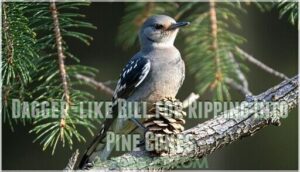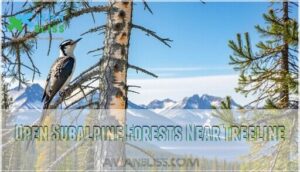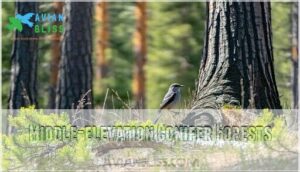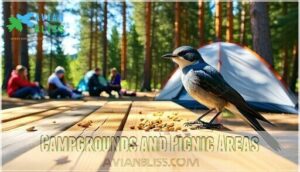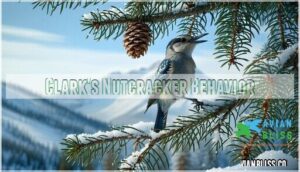This site is supported by our readers. We may earn a commission, at no cost to you, if you purchase through links.

This gray-and-black aerial acrobat with white wing flashes has transformed the American West’s forests through an extraordinary habit: burying up to 100,000 pine seeds each fall.
You’ll find these dagger-billed birds jabbing into whitebark pine cones across subalpine forests, stuffing seeds into a special throat pouch before caching them miles away.
Their razor-sharp memory helps them relocate most stashes during winter’s harsh months, but the seeds they forget? Those become tomorrow’s towering pines.
Clark’s nutcracker basically plants entire forests, making them nature’s most dedicated reforestation crew.
Their remarkable seed-caching abilities reveal surprising strategies that guarantee forest survival, and demonstrate how they play a crucial role in shaping their ecosystem through seed caching.
Table Of Contents
- Key Takeaways
- Clark’s Nutcracker Overview
- Nutcracker Physical Traits
- Nutcracker Habitat Preferences
- Clark’s Nutcracker Behavior
- Nutcracker Diet and Foraging
- Ecological Importance of Nutcrackers
- Conservation Status and Threats
- Frequently Asked Questions (FAQs)
- What are some fun facts about Clark’s Nutcracker?
- What is the difference between a Clark’s Nutcracker and a Canada Jay?
- Why is it called Clark’s Nutcracker?
- Where are Clark’s nutcrackers found?
- Why is it called Clark’s nutcracker?
- What is the difference between a Canada jay and a Clark’s nutcracker?
- What does a Clark’s nutcracker eat?
- How far can a Clarks Nutcracker travel daily?
- What is the typical lifespan of a Clarks Nutcracker?
- How does a Clarks Nutcracker locate its buried seeds?
- Conclusion
Key Takeaways
- You’ll witness one of nature’s most impressive memory feats – Clark’s nutcrackers can remember up to 9,000 seed cache locations across 200 square miles, even after months pass and snow covers everything.
- You’re looking at forest architects in action when you see these birds – they cache up to 98,000 pine seeds annually, and the ones they forget become tomorrow’s pine forests, making them essential for high-elevation forest regeneration.
- You’ll recognize them by their distinctive gray bodies, jet-black wings with white flashes, and dagger-like bills that they use to rip open tough pine cones and extract seeds with surgical precision.
- You’ll find these remarkable corvids in western North America’s high-elevation coniferous forests between 3,000-12,000 feet, where they face serious threats from climate change, habitat loss, and declining pine populations that could disrupt their crucial ecological role.
Clark’s Nutcracker Overview
You’ll find Clark’s Nutcracker in the high mountain forests of western North America, where this gray and black corvid has earned its reputation as nature’s most dedicated tree planter.
This jay-sized bird uses its sharp, dagger-like bill to extract pine seeds from cones, then buries thousands of them across the landscape for winter storage, making it a key figure in the ecosystem as a dedicated planter.
This high-mountain corvid plants forests one buried seed at a time.
Physical Characteristics
You’ll recognize Clark’s nutcracker by its jay-sized frame and distinctive gray plumage contrasting with jet-black wings.
This compact bird measures 10.6-11.8 inches long, sporting a daggerlike bill perfect for cracking pine cones.
White flight feathers flash during flight, while its sturdy build handles harsh mountain conditions with ease.
Habitat and Distribution
You’ll find Clark’s nutcracker across western North America’s mountain ecosystems, from British Columbia to Baja California.
These birds call high-elevation forests home, thriving in the subalpine zone between 3,000-12,000 feet elevation.
Their habitat preferences include:
- Whitebark and limber pine forests near treeline
- Open coniferous woodlands with Douglas-fir and spruce
- Pinyon-juniper communities at middle elevations
- Exposed ridges and slopes for seed caching
- Forest edges and meadow borders throughout their range.
The California Department of Fish and Wildlife maintains a dataset showing the nutcracker’s range maps.
Clark’s nutcracker shows remarkable habitat adaptations, moving seasonally between elevation ranges to track cone crops and access cached seeds across diverse forest types throughout these geographic regions.
Behavior and Diet
Clark’s nutcracker feeding behavior revolves around seed caching and social foraging.
You’ll witness these corvids extracting pine seeds with specialized bills, storing up to 33,000 seeds annually.
Their caching behavior involves burying seeds in scattered locations, creating essential food reserves.
Diet variation includes insects, berries, and carrion beyond pine seeds.
Social behavior emerges through loose flocks, though food theft occurs between individuals during competitive foraging situations.
Their ability to adapt and survive is also linked to their specialized bills.
Nutcracker Physical Traits
You’ll spot Clark’s Nutcracker by its distinctive gray body and contrasting black wings that create a striking pattern against mountain forests.
This jay-sized bird carries a long, sharp bill perfect for cracking tough pine cones and a special throat pouch that holds up to 150 seeds at once, which is a key feature for its survival.
Gray and Black Plumage
At first glance, you’ll notice the clark’s nutcracker’s striking bird color pattern combines ash-gray body feathers with jet-black wings.
This plumage variation serves a camouflage purpose against rocky mountain terrain and tree bark.
The feather composition remains consistent year-round, as these birds don’t undergo dramatic seasonal molting process changes.
Color genetics create this distinctive two-toned appearance that makes identification straightforward in their high-altitude habitat.
White Flashes in Tail and Wing
You’ll notice distinctive white flashes when Clark’s nutcracker takes flight.
White outer tail feathers create bold contrasts against the black wings and central tail. The secondary edge shows white trailing bands that aid in flight identification.
These white tail feathers serve important functions during aerial maneuvers. Bird identification becomes easier when you spot this striking bird color pattern of white markings against dark plumage.
Dagger-like Bill for Ripping Into Pine Cones
Look beyond their flashy white markings, and you’ll spot the Clark’s nutcracker’s most impressive feature—that long, daggerlike bill.
This specialized tool evolved perfectly for cone extraction, letting these birds rip open tough pine cones with surgical precision. The sharp, slightly curved bill morphology gives nutcrackers incredible leverage for seed acquisition.
While other birds struggle with cone scales, nutcrackers use their foraging adaptations to access hidden seeds efficiently. This bill evolution represents nature’s perfect engineering for seed extraction in harsh mountain environments, showcasing the perfectly evolved tool for this specific task.
Pouch Under Tongue for Storing Seeds
Beyond that sharp bill, you’ll find the Clark’s nutcracker’s secret weapon: a sublingual pouch tucked beneath its tongue.
This specialized storage compartment can hold up to 150 pine nuts at once, transforming each bird into a living seed vault. The pouch anatomy allows efficient seed transport across miles of mountain terrain.
Here’s how this caching system works:
- Seed Capacity – The expandable pouch stretches to accommodate dozens of whitebark pine seeds
- Caching Efficiency – Birds can make multiple trips, storing thousands of seeds daily
- Evolutionary Advantage – This adaptation lets nutcrackers survive harsh winters when food is scarce
- Pine Seed Caching – Each bird buries up to 33,000 seeds annually in strategic locations
- Seed Transport – The pouch keeps seeds secure during long flights between cone sources and cache sites
This remarkable feature gives Clark’s nutcracker an edge in the unforgiving alpine environment, where planning ahead means the difference between life and death.
Nutcracker Habitat Preferences
You’ll find Clark’s Nutcracker in high-elevation coniferous forests throughout western North America, typically between 3,000 and 12,000 feet where whitebark and limber pines thrive.
These gray corvids aren’t shy about venturing into campgrounds and picnic areas, boldly approaching visitors for handouts.
While maintaining their primary residence in the open subalpine forests near treeline.
Open Subalpine Forests Near Treeline
You’ll find Clark’s nutcracker thriving in open subalpine forests just below treeline, where high-elevation forests meet alpine zones.
Their treeline seed caching behavior becomes most apparent here, as they expertly harvest pine nuts from wind-battered conifers, demonstrating high-altitude adaptation and subalpine birdlife.
This subalpine birdlife perfectly demonstrates conifer forest ecology at its most challenging elevations, though climate change impacts increasingly threaten these specialized mountain habitats, particularly where whitebark and limber pines dominate.
Middle-elevation Conifer Forests
You’ll encounter Clark’s nutcracker in middle-elevation conifer forests spanning 3,000 to 8,000 feet, where diverse forest composition creates ideal seed dispersal opportunities.
These elevation gradients support ponderosa pine, Douglas-fir, and pinyon pine stands that nutcrackers rely on for seed caching.
The birds navigate between different forest types, adapting their highelevation forests expertise to varied whitebark pine populations across changing climate impacts zones.
Campgrounds and Picnic Areas
While campgrounds and picnic areas aren’t Clark’s nutcracker’s natural mountain habitats, these bold birds have mastered the art of food scavenging around human activity.
You’ll spot them hopping between picnic tables, investigating unattended snacks with their dagger-like bills.
Their campground behavior includes loud calls and fearless human interaction, making them excellent birdwatching locations despite noise impact concerns.
These birds are also known to cache seeds, using their remarkable spatial memory to find them later.
Clark’s Nutcracker Behavior
You’ll spot Clark’s Nutcracker through their distinctive behaviors that make them stand out in mountain forests.
Watch for their aggressive jabbing motions as they attack pine cones with their dagger-like bills, and listen for their harsh, grating calls that carry across the high-elevation landscape.
They travel in small, social groups, where they can be heard and seen exhibiting these unique characteristics, including their harsh calls.
Jab at Cones With Bills
When you watch a Clark’s nutcracker work, you’ll see impressive bill morphology in action.
This bird’s dagger-like bill serves as a specialized tool for cone extraction, perfectly adapted for accessing pine seeds.
The nutcracker uses precise foraging technique, jabbing its sharp bill between cone scales to reach hidden seeds.
These bill adaptations allow efficient seed access, making the clarks nutcracker a master of pine cone manipulation and seed dispersal.
Travel in Small Groups
After working at cones, Clark’s nutcrackers rarely forage alone.
These social birds demonstrate fascinating flocking behavior, gathering in loose groups of three to twelve individuals during fall and winter.
You’ll spot juvenile groups staying together after leaving their parents, learning cooperative defense strategies against predators like hawks.
This group foraging behavior helps nutcrackers locate the best seed sources across their mountainous habitat.
Birdwatching enthusiasts find their social hierarchy particularly interesting, as dominant birds often lead these wandering flocks through the forest canopy, making bird photography opportunities more predictable when multiple nutcrackers appear together.
Long, Grating Calls
You’ll hear Clark’s Nutcracker’s distinctive grating calls echoing across mountain forests as these social birds communicate with their flockmates.
Their harsh, mechanical "kraak-kraak-kraak" call pattern serves multiple purposes – coordinating flock movements, alerting others to predators, and maintaining contact across vast territories.
Each Nucifraga columbiana shows individual variation in call frequency and tone, creating unique vocal signatures within their complex communication system.
These calls are a form of vocal bird communication.
Wide-ranging and Move Through Forests
Clark’s Nutcracker populations don’t stay put in one location like many birds. Instead, these forest wanderers exhibit remarkable nomadism, traveling vast distances across mountain ranges to follow food sources.
Their territory size can span hundreds of square miles as they search for productive seed crops.
- Forest Dispersal: Nutcrackers move between different forest patches, spreading seeds across mountain landscapes
- Elevation Changes: They migrate from high-elevation summer areas to lower winter zones following seasonal movements
- Seasonal Movements: Fall brings downhill travel to access abundant pine seeds in middle-elevation forests
- Territory Size: Individual birds may cover 15-20 square miles during peak seed caching season
Nutcracker Diet and Foraging
You’ll discover that Clark’s Nutcracker feeds primarily on fresh and stored pine seeds, which make up the bulk of their diet throughout the year.
These resourceful birds also supplement their nutrition with insects, berries, eggs, nestlings, carrion, and human-provided foods like peanuts and suet when available.
Fresh and Stored Pine Seeds
Pine seeds form the nutritional backbone of a Clark’s Nutcracker’s diet, with these birds consuming both fresh seeds directly from cones and retrieving cached stores throughout winter.
Using specialized Seed Caching Methods, nutcrackers bury up to 98,000 pine seeds annually, relying on remarkable Spatial Memory to locate buried caches months later.
This Winter Survival strategy guarantees access to high Nutritional Value pine nuts when fresh food becomes scarce, supporting both individual survival and forest Seed Dispersal through forgotten caches that promote Seed Germination.
Other Food Sources Like Peanuts and Suet
Beyond pine seeds, you’ll find Clark’s Nutcrackers enthusiastically accepting human provisioning at mountain feeders.
These omnivores readily consume peanuts and suet, which offer high nutritional value during harsh winters.
Supplemental feeding through backyard birding attracts these intelligent birds to developed areas.
Many birders find bulk wild peanuts are a favorite snack for these birds.
Their alternative diets demonstrate remarkable food availability adaptations.
Bird foraging techniques include boldly approaching campsites for energy-rich offerings when natural resources become scarce.
Larger Seeds and Nuts
You’ll discover that Clark’s Nutcracker handles larger seeds and nuts with impressive skill.
Their Seed Preference extends beyond pine seeds to include acorns, hazelnuts, and sunflower seeds when available.
These birds adapt their Caching Strategies for different seed sizes, burying larger items individually rather than in clusters.
The Nutritional Value of diverse seeds supports their energy needs during harsh winters.
This flexible diet enhances Forest Expansion as forgotten caches create mixed forest communities, strengthening the symbiotic relationship between Clarks Nutcracker and various tree species through effective seed dispersal.
Ecological Importance of Nutcrackers
You’ll discover that Clark’s nutcrackers aren’t just seed collectors – they’re nature’s forest planners who cache tens of thousands of pine seeds each fall.
The seeds they forget or can’t retrieve become tomorrow’s pine trees, making these gray birds essential architects of high-elevation forests across western North America.
Bury Seeds for Winter
Each fall, you’ll witness one of nature’s most impressive preparation strategies as Clark’s Nutcracker engages in seed caching behavior.
Nature’s master planner buries up to 98,000 seeds each fall for winter survival.
These remarkable birds store up to 98,000 pine seeds per season, burying them in thousands of cache sites across mountainous terrain.
Their extraordinary spatial memory enables precise cache retrieval months later, ensuring winter survival when fresh food becomes scarce in snow-covered forests.
These seeds are often purchased as pine seeds bulk for various uses, highlighting the importance of pine seeds in different contexts, and demonstrating a unique aspect of winter survival.
Seeds They Don’t Retrieve Grow New Pine Forests
While Clark’s nutcrackers retrieve most cached seeds, they can’t find every buried treasure.
These forgotten seeds become nature’s lottery tickets, sprouting into new pine forests across mountainous landscapes.
The birds’ imperfect spatial memory creates unexpected groves in locations far from parent trees, expanding forest boundaries naturally.
- Forgotten caches establish pine stands in previously unforested areas
- Seed dispersal occurs across distances impossible for wind-dispersed seeds
- High-elevation pines depend entirely on nutcrackers for long-distance colonization
- Single birds transport thousands of seeds annually, creating genetic diversity hotspots with significant impact on genetic diversity
Crucial Role in Forest Regeneration
Nature’s most skilled forest planner, the Clark’s nutcracker transforms landscapes through seed dispersal that creates entire ecosystems.
Your mountain forests depend on this bird’s caching behavior for pine regeneration. Each nutcracker plants thousands of seeds across vast territories, with forgotten caches becoming tomorrow’s forests.
This ecosystem impact extends beyond individual trees—it’s habitat creation on a massive scale. Protecting these areas helps to guarantee support for biodiversity.
| Regeneration Aspect | Nutcracker Impact |
|---|---|
| Whitebark pine forests | 100% depend on nutcracker dispersal |
| Annual seed transport | Up to 100,000 seeds per bird |
| Maximum dispersal distance | 32.6 kilometers from source |
| Cache recovery rate | 52-78% retrieved by birds |
| Forest connectivity | Links fragmented pine populations |
Conservation Status and Threats
You might be surprised to learn that scientists don’t have a clear picture of how Clark’s Nutcracker populations are doing across their range.
What we do know is troubling: climate change threatens their high-elevation homes, habitat loss reduces available nesting sites, and food shortages from pine die-offs create serious survival challenges, particularly due to habitat loss.
Overall Population Trend Not Well Known
Scientists can’t pin down exactly how Clark’s nutcracker populations are changing.
Population data gaps and monitoring challenges make trend identification nearly impossible.
These birds move vast distances following food sources, making consistent population monitoring extremely difficult.
Their boom-and-bust lifestyle tied to cone crops creates wild population swings that mask long-term trends.
This uncertainty has major conservation implications, leaving researchers scrambling to establish research priorities for protecting these ecologically important forest engineers.
Globally, habitat loss threatens 78% of bird species, which is a significant concern for bird conservation and highlights the need for urgent action to protect these species.
Vulnerability to Climate Change
Climate change hits Clark’s nutcracker populations hard through range contraction and habitat shifts.
Rising temperatures squeeze these birds toward mountaintops, shrinking available territory by over fifty percent under warming scenarios.
Pine decline from beetles and disease eliminates essential food sources, and fire frequency increases, destroying seed trees.
Meanwhile, seedling survival drops as conditions become too harsh, and population monitoring reveals some regions face near-complete habitat loss, making conservation and habitat protection urgent priorities.
Habitat Loss and Food Scarcity
As development encroaches on high-elevation forests, Clark’s nutcrackers face shrinking habitat and dwindling food supplies.
Forest fragmentation disrupts their seed-caching networks, while climate impacts push suitable habitat upslope.
This habitat loss threatens their ecological importance in forest regeneration, making conservation efforts essential for preserving these remarkable birds.
- Forest fragmentation breaks up continuous habitat into isolated patches
- Seed decline occurs when pine cone production drops due to environmental stress
- Competition increase happens as birds crowd into remaining suitable areas
- Climate impacts force nutcrackers to seek new elevation ranges for survival
- Conservation efforts focus on protecting key whitebark and limber pine forests
Increased Competition and Disease Outbreaks
When resource scarcity strikes, Clark’s nutcracker faces fierce competition from other corvids and rodents for dwindling pine seeds.
Disease vectors like white pine blister rust devastate their primary food sources, while mountain pine beetle outbreaks compound the crisis.
These outbreak impacts trigger population pressures that force nutcrackers into unfamiliar territories, increasing mortality rates.
Without effective conservation strategies addressing these interconnected threats, the ecological importance of this forest engineer remains at serious risk.
Frequently Asked Questions (FAQs)
What are some fun facts about Clark’s Nutcracker?
Like feathered pirates hoarding treasure, these birds cache up to 98,000 pine seeds annually, remembering thousands of locations months later even under snow, making them forest architects through forgotten seeds.
What is the difference between a Clark’s Nutcracker and a Canada Jay?
You’ll spot the difference easily: Clark’s Nutcracker has a long, dagger-like bill and gray body with black wings.
While Canada Jay sports a shorter, crow-like bill and fluffy gray plumage without contrasting wing colors.
Why is it called Clark’s Nutcracker?
Straight from the horse’s mouth, you’ll find it’s named after Captain William Clark from the Lewis and Clark expedition.
He collected the first scientific specimen in 1805, earning this seed-caching corvid its scientific and common name recognition.
Where are Clark’s nutcrackers found?
You’ll find Clark’s nutcrackers in high-elevation coniferous forests across western North America, from British Columbia and Alberta south to Baja California, typically between 3,000-12,000 feet elevation.
Why is it called Clark’s nutcracker?
You’d think this bird would crack nuts, but it’s actually named after William Clark from Lewis and Clark’s expedition, who documented this seed-caching corvid during their western exploration.
What is the difference between a Canada jay and a Clark’s nutcracker?
Canada jays are larger, grayer overall birds with fluffy plumage and shorter, blunter bills.
You’ll notice Clark’s nutcrackers have distinctive black wings, white outer tail feathers, and longer, dagger-like bills for cracking seeds.
What does a Clark’s nutcracker eat?
Like a feathered treasure hunter, you’ll find Clark’s nutcracker primarily eats pine seeds, which it extracts with its dagger-like bill and stores by thousands for winter survival.
How far can a Clarks Nutcracker travel daily?
You can observe Clark’s Nutcrackers traveling several miles daily while foraging, but they don’t migrate long distances. Their movements depend on seed availability and seasonal changes in elevation.
What is the typical lifespan of a Clarks Nutcracker?
Working like a master storyteller, your feathered friend can live up to seventeen years in the wild.
With records showing one remarkable bird reaching seventeen years and five months before being recaptured during banding studies in Oregon.
How does a Clarks Nutcracker locate its buried seeds?
You’ll navigate back to buried seeds using remarkable spatial memory, remembering thousands of cache locations even after months pass and snow covers everything completely.
Conclusion
Consider this remarkable fact: a single Clark’s nutcracker can remember the locations of up to 9,000 seed caches scattered across 200 square miles.
These exceptional birds demonstrate nature’s perfect balance between individual survival and ecosystem health.
When Clark’s nutcracker retrieves cached seeds during winter, the forgotten seeds germinate into new pine forests.
Their forgetfulness becomes the forest’s gain, creating a continuous cycle of regeneration.
Through their seed-caching behavior, these birds guarantee both their survival and the expansion of high-elevation forests across the American West, ensuring a remarkable example of nature’s balance.
- https://www.audubon.org/field-guide/bird/clarks-nutcracker
- https://www.nps.gov/brca/learn/nature/clarknutcracker.htm
- https://www.allaboutbirds.org/guide/Clarks_Nutcracker/lifehistory
- https://a100.gov.bc.ca/pub/eswp/esr.do;jsessionid=CmsHWRWZqdp0BpP1GFL4RCk4TN4PT3QYStWSjwvjY292pjn1fxBX!-1508492824?id=14912
- https://en.wikipedia.org/wiki/Clark's_nutcracker



